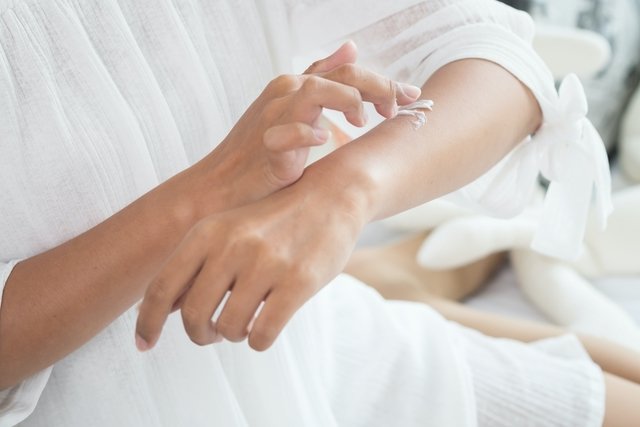Ointments for allergies and itchy skin, such as calamine ointment, antiallergic ointment or corticosteroid ointments, contain substances with anti-allergic, anti-inflammatory, calming or skin-protective action, which help to relieve itching.
Itchy skin can be caused by various diseases, such as allergies, very dry skin, insect bites, sunburn, dermatitis, psoriasis, chickenpox or ringworm, for example. See the main causes of skin allergies.
Ointments for allergies and itchy skin can be purchased in pharmacies or drugstores, and it is important to use them with advice from your general practitioner or dermatologist according to the cause of the allergy and itchy skin, the length of treatment and the individual doses.

Top ointments for allergies and itchy skin
Some ointments most recommended by doctors to relieve itchy skin are:
1. Calamine ointments
Calamine is a substance made up of zinc oxide and other components, which act to relieve itching, due to its astringent and skin-protective properties. Calamine ointments and creams can be used alone or as a complement to the treatment prescribed by the doctor, in various situations, such as allergies, insect bites, sunburn or chicken pox.
Some examples of products with calamine are Ducilamine from TheraSkin, which can be used in adults and children, and Calamyn, Solardril and Caladryl, which can be used in adults and children over 2 years old, because they contain camphor in their composition, which is contraindicated in children under 2 years of age. See an ointment that can be used on the baby.
2. Anti-allergy ointments
Antiallergic ointments mainly contain antihistamine substances, and can be used for skin allergies, such as atopic dermatitis or insect bites, for example, because they act by reducing the allergy and reducing itching.
Some examples of ointments or creams with antihistamines are Profergan or Phenergan, with promethazine in the composition, and Polaramine, with dexchlorpheniramine in the composition. These products should only be used in children over 2 years of age.
3. Corticosteroid ointments
Corticosteroids in ointment or cream are medicines widely used to treat itching in situations where there is a lot of discomfort and/or where other treatments have not been effective.
Generally, these ointments are widely used as aids in the treatment of psoriasis, associated with antifungals in mycoses, insect bites or severe allergies, eczema or atopic dermatitis, for example, but they should only be used if recommended by a doctor.
Some examples of corticosteroid ointments or creams that the doctor may recommend are Berlison or Hidrocorte, with hydrocortisone, Cortidex, with dexamethasone, or Esperson, with desoximethasone. Find out what precautions to take with corticosteroids.
4. Moisturizing, nourishing and soothing creams
In some cases, itching may occur due to extreme dryness and dehydration of the skin, atopic dermatitis or skin irritation caused by chemicals or waxing, for example.
In these cases, the use of a good moisturizing, nourishing and soothing cream may be enough to put an end to the discomfort and itching felt on the skin. However, it is important to be careful if you have skin with atopic dermatitis, as in these cases specific products must be used, with few ingredients and as gentle as possible.
Some examples of creams that can be used to gently nourish and hydrate the skin are Avéne’s Xeracalm Relipidizing Balm, Fisiogel AI or La Roche Posay’s Lipikar Baume AP+. Furthermore, Sesderma’s Hidraloe Gel is also a great option for skin with irritation, insect bites, light burns or itching, because it has 100% aloe vera in its composition, with a calming and softening action.
When to go to the doctor
It is important to consult a dermatologist whenever allergies and itchy skin appear that do not improve or are accompanied by other symptoms, such as:
- Red and/or gray spots or lesions on the skin;
- Peeling, swelling or irritation of the skin;
- White or red dots on the skin;
- Blisters on the skin, which can rupture and release liquid;
- Dryness of the skin;
- Crusts or cones;
- Burning or burning sensation;
- Change in skin sensitivity.
Therefore, the doctor must evaluate the symptoms, health history and request diagnostic tests, in order to identify the cause of the itching and allergy, and thus recommend the most appropriate ointment or other treatments.
Taking care of your health has never been easier!
Bibliography
- NOWAK, D. A.; YEUNG, J. Diagnosis and treatment of pruritus. Can Fam Physician. 63. 12; 918-924, 2017
- SONG, J.; et al. Pruritus: Progress toward Pathogenesis and Treatment. Biomed Res Int. 2018. 9625936, 2018
- THERASKIN. Ducilamine. Available at: <http://www.saudedireta.com.br/catinc/drugs/bulas/ducilamina.pdf>. Accessed on May 10, 2019
- MAYO CLINIC. Psoriasis. Disponível em: <https://www.mayoclinic.org/diseases-conditions/psoriasis/symptoms-causes/syc-20355840>. Acesso em 10 mai 2019
- ANVISA. Polaramine. 2018. Available at: <http://www.anvisa.gov.br/datavisa/fila_bula/frmVisualizarBula.asp?pNuTransacao=1780772018&pIdAnexo=10477083>. Accessed on May 10, 2019
- TEUTO. Profergan. 2015. Available at: <http://www.anvisa.gov.br/datavisa/fila_bula/frmVisualizarBula.asp?pNuTransacao=6154962015&pIdAnexo=2735847>. Accessed on May 10, 2019
- SANOFI. Fenergan. 2015. Available at: <http://www.anvisa.gov.br/datavisa/fila_bula/frmVisualizarBula.asp?pNuTransacao=7556382015&pIdAnexo=2822071>. Accessed on May 10, 2019
- NEO CHEMISTRY. Calamyn. 2017. Available at: <http://www.anvisa.gov.br/datavisa/fila_bula/frmVisualizarBula.asp?pNuTransacao=24404762017&pIdAnexo=10363534>. Accessed on May 10, 2019
- JOHNSON & JOHNSON. Caladryl. Available at: <http://www.saudedireta.com.br/catinc/drugs/bulas/caladryl.pdf>. Accessed on May 10, 2019
- Onofre CVS pharmacy. Available at: <https://www.onofre.com.br/>. Accessed on May 10, 2019
- SANOFI. Esperson. 2014. Available at: <https://www.onofre.com.br/estaticos/bulas/017523.pdf>. Accessed on May 10, 2019
- SESDERMA. HYDRALOE ALOE GEL. Available at: <http://www.sesderma.pt/pt/categorias/familias/hidraloe/hidraloe-gel-de-aloe.html>. Accessed on May 10, 2019

Sign up for our newsletter and stay up to date with exclusive news
that can transform your routine!
Warning: Undefined array key "title" in /home/storelat/public_html/wp-content/plugins/link-whisper-premium/templates/frontend/related-posts.php on line 12
Warning: Undefined array key "title_tag" in /home/storelat/public_html/wp-content/plugins/link-whisper-premium/templates/frontend/related-posts.php on line 13



